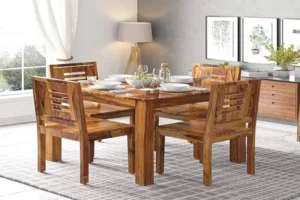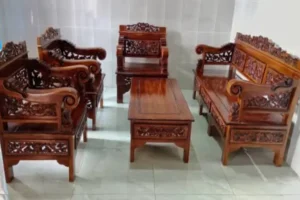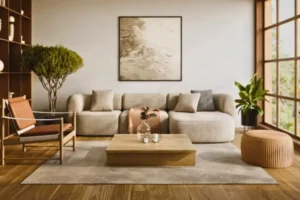Most people decide to purchase furniture because they want it to last long while looking great and delivering value. People choose rosewood furniture because it offers both remarkable aesthetics and excellent durability. Before deciding on rosewood furniture, you need to know its advantages, disadvantages and ethical risks. We will show you how to determine if rosewood furniture fits your needs.
What is Rosewood?
Rosewood stands out for its colourful texture and durable nature when used in hardwood furniture construction. People locate natural rosewood deposits in South American, Indian, and African regions. The wood serves as a primary material for furniture production plus musical and decorative items.
Types of Rosewood

Rosewood takes multiple forms, such as:
- Indian Sheesham (Rosewood) – Remains distinctive as an official wood of Indian furniture production.
- Brazilian Rosewood – Remains scarce and expensive because makers use it mostly in premium furniture creations.
- Madagascar Rosewood – Known for its deep reddish colour and fine grains.
- Burmese Rosewood – Stands out for its strength and serves premium furniture production.
Every kind of rosewood possesses special traits but demonstrates remarkable power and visual appeal at once.
Benefits of Rosewood Furniture

1. Strong and Durable
Rosewood holds the title of being one of the most durable materials to make furniture due to its sturdy wood nature. The material stays strong for many years without changing its performance.
2. Beautiful Appearance
Rosewood has its natural sheen and deep reddish brown colour which improves the aesthetic look of homes. Its polished appearance and distinctive wood grain patterns make it obvious in a space.
3. Resistant to Termites and Decay
The organic oils inside rosewood help prevent it from insect damage and decay for long-lasting usage.
4. Easy Maintenance
The wood needs limited polishing as rosewood differs from other types in this regard. Light dusting with periodic oil application helps the furniture maintain a new appearance.
5. High Resale Value
The durability and quality of rosewood furniture help it keep good value throughout its life. The antique rosewood furniture pieces have strong market value.
6. Heavy and Sturdy
Rosewood furniture weighs heavily to stay stable during use because it resists breaking. It handles heavy pieces such as tables, chairs and cabinets because of its weight.
Note – 10 Best Tips to Design Wardrobe for Your Children
Drawbacks of Rosewood Furniture

1. Expensive
Rosewood furniture costs more than pine and mango wood products due to its special features. The wood’s resistance to damage and elegant look make the final cost high.
2. Limited Availability
The cutting ban on rosewood trees and deforestation reduction drive this wood toward extinction. Several nations prevent the trade of particular types of rosewood.
3. Heavy Weight
Its heaviness shows the excellent quality yet becomes a challenge when moving furniture. Moving your room’s interior regularly becomes challenging because of this issue.
4. Environmental Concerns
Many parts of the world have made rosewood trees an endangered species. The rising demand for rosewood causes politicians to illegally log these areas which hurts forests and destroys wildlife. Environment protection becomes more critical when deciding about furniture purchases.
5. Requires Skilled Craftsmanship
This wood material is demanding because it does not yield easily to working tools. Inept woodworkers create surface damage when working with rosewood. It is crucial to purchase from well-known sellers.
Note – Transform Your Living Space with L-Shaped Sofas: Ideas of the Design and its Advantages
Should You Buy Rosewood Furniture?

Buy Rosewood Furniture If:
✅ You seek furniture made to last several decades without weakening.
✅ You seek beautifully crafted furniture designs in top-notch quality for your house.
✅ Because the price of premium furniture is no problem to you.
✅ The furniture pieces at your living location remain stationary.
✅ Purchasing from this supplier ensures both legal and environmentally friendly operations.
Avoid Rosewood Furniture If:
❌ You need furniture at a lower price.
❌ You relocate often and look for lightweight furniture choices.
❌ You feel concerned about natural forest loss and environmental impact.
❌ Spending more on advanced furniture treatments holds no interest for you.
Alternatives to Rosewood Furniture
When you choose not to buy rosewood furniture, you have several excellent choices available.
- Teak Wood – Durable, resistant to termites, and widely available.
- Oak Wood – Strong and long-lasting with a natural finish.
- Mango Wood – Affordable and sustainable, but not as durable as rosewood.
- Sheesham Wood – A close alternative to rosewood, but less expensive.
How to Identify Genuine Rosewood?

Consider purchasing rosewood furniture only when you receive certifiable proof of its authenticity. Here are some tips:
✔ Authentic rosewood furniture weighs more than poor-quality alternatives, even when all pieces share the same size and shape.
✔ The wood shows natural reddish-brown tones with fine grain textures.
✔ Genuine rosewood gives a mild, enjoyable aroma through its natural oil content.
✔ Stroke the board gently, and it should yield a solid ringing sound rather than a weak hollow tone.
✔ Request proof from your seller before buying to verify wood source compliance with legal standards.
Read more about – How to Stain Furniture: A Step-by-Step Guide
Conclusion
People choose Rosewood furniture to enhance their spaces because it offers both style and durability. Its dense yet resilient qualities give rosewood excellent everyday use value in interior décor. The product carries expensive prices plus weighs heavily, along with questions about its environmental impact on wood preservation.
Make sure to buy legal and environmentally friendly rosewood furniture products. Customers searching for good deals or environmentally-friendly options can explore teak oak and Sheesham wood, which deliver comparable durability and style.
Ultimately, your decision should be based on your budget, lifestyle, and environmental considerations. Weigh the pros and cons carefully to choose furniture that best suits your needs and values.


